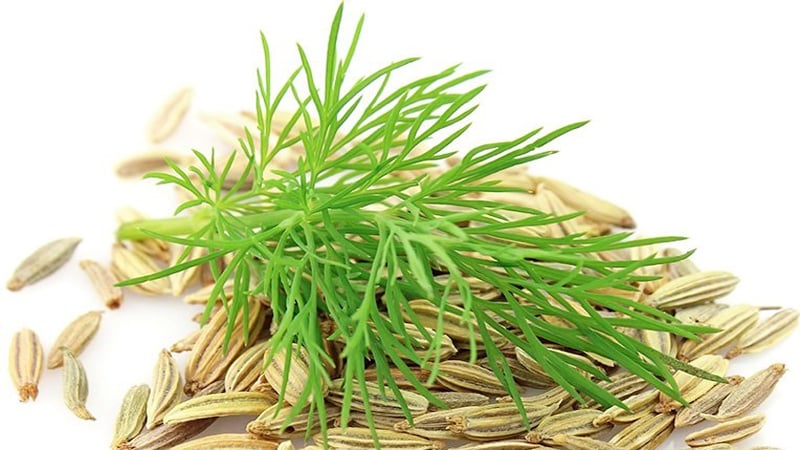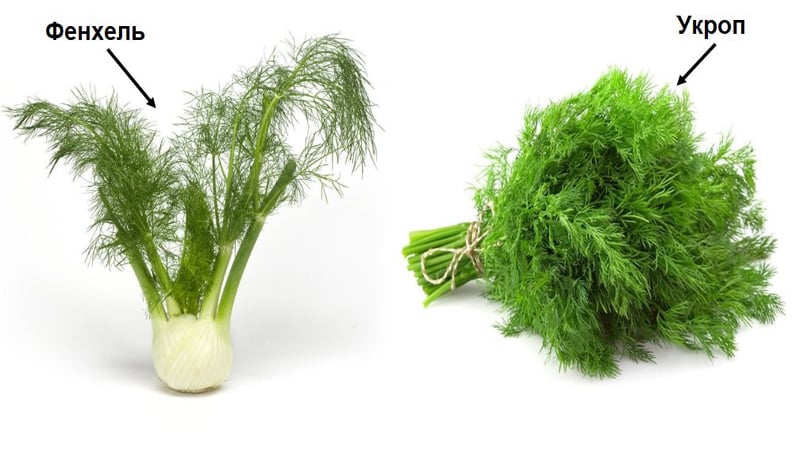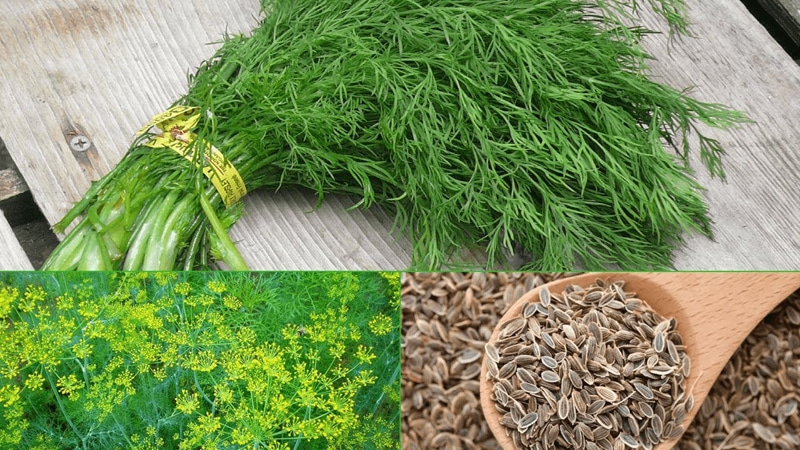What is the difference between fennel and dill, how to distinguish them and where to use them
Fennel and dill are two similar plants with fluffy thin leaves and inconspicuous yellow flowers collected in umbrellas. Both plants are aromatic, but one is called the familiar word dill, and the second is called unusually - fennel. Let's figure out what the difference is between fennel and dill, and why they are used for different purposes.
Fennel - botanical description
Fennel (Foeniculum) is a genus of herbaceous perennial plants belonging to the Apiaceae family, class Dicotyledons.
Botanical characteristics of the genus Fennel:
- The root system is taproot.
- The stem is up to 2 m high, erect, branched, light green in color.
- The leaves are three or four times pinnately dissected.
- The flowers are collected in an inflorescence of a complex umbrella, the calyx of the flower is of an open type, the petals are yellow and wide.
- The fruit is ovoid, oblong, round in diameter, the semi-fruits have 5 blunt ribs, of which the marginal ones are elongated and form a wing-shaped edge.
The genus Fennel includes 3 known species: vegetable, oilseed and ordinary, which is often called “pharmacy dill”.
Dill - botanical description

Dill (Anethum) is a genus of annual herbaceous plants of the Apiaceae family, class Dicotyledons. This genus consists of a single species - Dill (Anethum graveolens), which is called garden dill.
Botanical characteristics of the genus Dill:
- The root system is taproot.
- The stem is 40-150 cm high, erect, branched, bright green.
- The leaves are three or four times pinnately dissected, ovate, and sit on long petioles.
- The flowers are collected in complex umbels, the calyx is of an open type, the petals are yellow and wide.
- The fruit is a bean carp, the seeds are ovoid with 2 ribs growing into a wing-shaped thickening and 3 small ribs.
From a biological point of view, dill and fennel are distant relatives.
Comparison of dill and fennel: distinctive features

Dill and fennel are plants of different kinds, but of the same family - Apiaceae. Because of the trivial name “dill,” fennel is often confused with its fragrant distant relative, which is common in the garden. If you have dill growing in your garden that smells like anise, you are growing fennel.
The following signs will help you distinguish dill from fennel:
| Distinctive feature | Common fennel | Dill fragrant |
| Stem height | 90-200 cm | 40-150 cm |
| Stem color | Light green with a silvery tint | Bright green |
| Smell of leaves and stems | Bright, spicy, with fresh mint and anise notes | Spicy, fresh, with notes of cut greens |
| The taste of the shoots | Delicate, dill-anise, sweetish | Strong, refreshing, tart |
| Seed shape | Elongated, 5-10 mm long, 2-3 mm wide | Oval, 3-5 mm long, 1.5-3.5 mm wide |
| Smell of seeds | Bright, spicy, fresh, has minty notes | Strongly spicy, tart, has woody notes |
| Taste of seeds | Specific, with anise aftertaste | Rich, spicy, with hints of cumin |
| Plant lifespan | 3-5 years | 1 year |
Fennel and dill are not the same thing, despite their external similarity. The main botanical indicator of their difference is the impossibility of obtaining a hybrid by crossing species, as is observed among species of the genus Citrus (for example, a hybrid of mandarin and lemon - rangpur).
Differences between fennel and dill
In addition to external signs, these plants have their own characteristics in cultivation and use, as they have different properties.
Features of growing fennel and dill are given in the table.
| Features of growing and harvesting | Common fennel | Dill fragrant |
| Landing method | Seedling and seed | Seminal |
| Soil moisture | High | High |
| Soil pH | Neutral | Neutral and alkaline |
| Neighbors in the garden beds | Single plant, it is not recommended to plant other plants | Gets along well with other crops |
| Frost resistance | Low, in central Russia fennel dies with the onset of cold weather | high, Dill seeds can successfully overwinter in the soil and germinate in the spring |
| Light mode | Light-loving plant, may die in the shade | Light-loving plant, but can grow in the shade |
| Harvesting leaves | July August | June July |
| Harvesting seeds | September | July – September |
Properties and features of the use of fennel and dill
The difference in the properties of these umbrella plants is due to the different chemical composition of the shoots and seeds.
Fragrant dill shoots contain:
- vitamin C;
- vitamin PP;
- carotene;
- vitamins B1 and B2;
- flavonoids;
- pectins;
- carbohydrates;
- essential oil;
- mineral salts.
Composition of dill fruits and seeds:
- fatty oil (15-18%);
- proteins (14-15%);
- carbohydrates;
- essential oil (2.5-8%).
The composition of the essential oil of shoots and seeds is different, which accounts for the difference in smell. Therefore, the leaves are used in cooking, and the seeds are used in medicine as a stimulant for the digestive glands, and also as a culinary seasoning for bread.
Fennel leaves and stems contain:
- vitamins B1, B2, B6;
- vitamin C;
- vitamin PP;
- vitamin A;
- mineral salts;
- carbohydrates;
- proteins;
- flavonoids;
- essential oils.
Composition of fennel seeds and fruits:
- vitamin A;
- vitamin E;
- vitamin C;
- vitamin K;
- vitamin PP;
- vitamin H;
- vitamins B1, B2, B6;
- essential oil (2-6%);
- fats (9-12%);
- carbohydrates.
Due to its specific smell, fennel essential oil is used in perfumery. Fatty fennel oil is used as a lubricant in technology. The leaves, fleshy stems and fruits are used in cooking. Medicines for the treatment of diseases of the respiratory, digestive, nervous and cardiovascular systems are obtained from the seeds.
The use of fennel and dill in cooking

Fennel is eaten in its entirety, from the fleshy bulbs to the aromatic seeds. In contrast, only young stems with leaves and dry seeds are collected for food from garden dill.
Dill is added for flavor to soups, salads, and side dishes. It is used to season fish, meat, vegetables and sauces.
The seeds of fragrant dill give rye bread a spicy, tart aroma. When canning vegetables, dry umbrellas with seeds are added to the brine.
The fleshy base of fennel stems is used in cooking as a separate product. The stems are stewed, fried and pickled like other vegetables.
Dried fennel leaves and seeds are an aromatic seasoning for fish, meat, vegetables and desserts. In Italy, Greece and other Mediterranean countries you can find fennel ice cream and chocolate with fennel seeds instead of nuts.
For bakers, fennel seeds are a seasoning for white bread. The minty-anise scent of fennel essential oil is used to impart a refined aroma to coffee, tea and cocoa.
Fennel is useful in making marinades and sauces for fish and meat.In Italy and India, it is customary to preserve and pickle fleshy onions and dill leaves. Fruits with an anise aroma are added to homemade sour berry jam.
Fennel and dill in folk medicine
Up to the 19th century strong decoctions umbrella plants were used as an abortifacient for unwanted pregnancy. Essential oils, when taken orally in large quantities, caused expulsion of the placenta and severe uterine bleeding; women often died after such methods treatment village doctors and midwives.
After studying the properties and chemical composition of essential oils of umbrella plants, their toxicity and maximum permissible doses were established.
Attention! Before using traditional medicine, consult your doctor.
Dill infusion has a diuretic effect. It is used to relieve swelling in hypertension. An infusion of seeds is used as a carminative for flatulence, as well as a sedative and sedative for insomnia. A solution of essential oil in apricot or peach oils is used externally to relieve itchy skin.
Fennel has a long history of medicinal use. Hippocrates used it as a diuretic, Dioscorides as an ophthalmic remedy, and Avicenna as an expectorant.
Dry seeds are included in laxative, carminative, thoracic, choleretic and sedative preparations. Essential oil is diluted with water (1 drop per 1 liter of water) to obtain dill water for the treatment of flatulence in children. An infusion of leaves and fruits is used as a sedative and antispasmodic. Use externally tincture of seeds for the treatment of acne and furunculosis.
Fresh fennel leaves and fruits are used to freshen breath. An infusion of a mixture of dry seeds of umbrella plants and mint leaves is used to rinse the mouth for toothaches.
Read also:
What are the benefits of dried dill, how to prepare and use it.
Conclusion
Fennel and dill are plants rich in vitamins and essential oils. Despite their external similarity, they have different compositions and properties. You can distinguish fennel from dill by the shape and aroma of the seeds, as well as the color, smell and taste of the shoots. Both plants are widely used in cooking, medicine and perfumery.